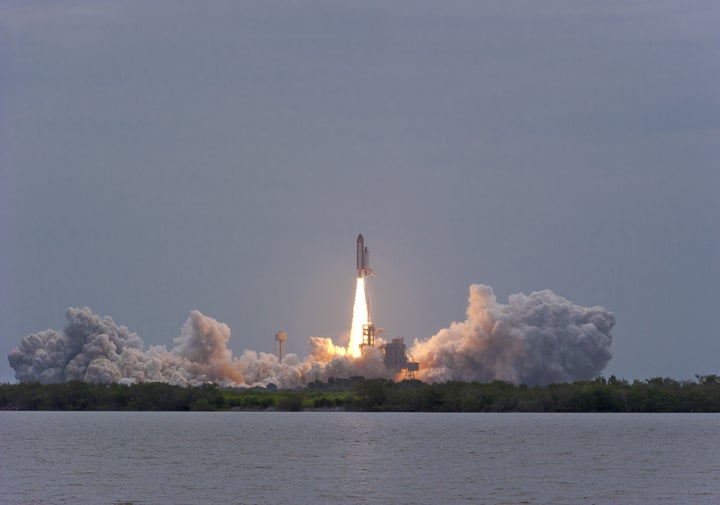
It was January 28th, 1986, and I was ten years old. My fellow elementary school students and I had gathered proudly in the auditorium, eager to watch a teacher fly into space. She had plans to teach two fifteen minute classes from orbit, and millions of students all over America were watching her go.
When we saw what looked like an explosion, the first thing we felt was confusion. Then fear. Then tears. Administrators called parents to pick us up early. Children at the school where she had taught were furiously chasing out the press.
At such a young age, I didn't fully understand the significance of the president canceling his State of the Union address that night, or the concerns that the Russians could exploit the tragedy for their own purposes, or the fear that the entire space program might be brought to a quick end. It would be years before I'd learn that the astronauts were likely still alive when they hit the water.
But I remember that President Reagan's Oval Office address about the tragedy was amazing. It flowed like poetry, sending the country into mourning with an enormous sense of pride. The crew of that ship had been, at the time, the most diverse ever, and Christa McAuliffe, the teacher, the first civilian to be sent to space, was a hero to everyone - especially to us kids.
Thirty years later, the Challenger has not been forgotten, but unfortunately, it seems that much of its spirit has. Exploring the heavens was an enormous point of national pride in 1986, a boldfaced arrow to the future. The space program inspired countless young Americans to become scientists and projected an image around the world of a country that could do extraordinary things - and do them together. NASA was, in today's terms, one of the most beloved and esteemed "brands" in the United States, not only changing the way Americans thought about science, but the way we thought about ourselves.
Even so, the space program did much more than inspire: it also directly paved the way for the technologically extraordinary world that we take for granted today. To pick just one of hundreds of examples, if you are reading this article online, it almost certainly came to you through a satellite. Who was figuring out how to get satellites into space efficiently and relatively inexpensively, long before their benefits were obvious to the average terrestrial? It was NASA - perhaps the greatest single research and development program ever undertaken, with economic and technological benefits still rippling out today.
Sadly, the space program of today is a shell of what it once was. The shuttles are all retired, on display in museums alongside relics like the Apollo capsules, and Cape Canaveral, once regularly rumbling with shuttle launches, is the Detroit of aerospace. The Martian may be nominated for Academy Awards in Hollywood, but in real life, NASA doesn't even currently have the capability to launch American astronauts to the International Space Station. Recent budget increases are a positive step but are nonetheless barely a shadow of the agency's glory days. Unless you're a multi-millionaire who can afford to pay for private sector space tourism (a venture which is itself still very much in a beta phase), the only way to get to space is through a Russian facility in Kazakhstan.
Private sector space exploration has its place, of course. Companies like Space X and Blue Origin are doing extraordinary things, and their development of reusable rockets will significantly reduce costs. Citizen space groups like the Open Space Agency are also doing exceptional work, with citizen astronomers just last year discovering countless new planets and galaxies from telescopes in their backyards. But these companies and organizations could do much more if they were part of a national effort to advance science and technology through aeronautics, as partners with NASA instead of pale replacements. Working in partnership with the private space industry, a better funded NASA could advance the sector at a rate not seen since the 1960s. They could establish a base on the moon, with low gravity launch-pads from which to explore our solar system and new telescopes that would peer into the deepest reaches of space, laying the groundwork for advances we can barely imagine.
When I was a child, astronauts were a symbol of the future, of what humanity - and America - was capable of. For my young son, I fear that astronauts may be a symbol of the past, of an adventurous age gone by. I don't want that to be the case. I want him to look to the heavens and know that if he studies hard at science and math, he can get there. I want his friends to know the same thing, for the very notion of it to inspire them like NASA inspired the kids of my generation - many of whom ended up working in places like Silicon Valley, inventing the future. I want him to see with his own eyes the living testament to human achievement that is embodied in every spacefaring venture, to know beyond a shadow of a doubt that there is nothing the human mind and the human spirit cannot achieve when we try.
That was the spirit of Challenger. That was what those losses, emblazoned upon my memory, were for. Those astronauts died, but their encapsulation of the best of humanity, of the human will to transcend the limitations of earthly existence both literally and metaphorically, lived on. It's up to all of us to make sure that their spirit lives on for the next generation as well.
